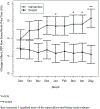A Group Randomized Intervention Trial Increases Participation in the School Breakfast Program in 16 Rural High Schools in Minnesota
- PMID: 30772298
- PMCID: PMC6536323
- DOI: 10.1016/j.jand.2018.12.007
A Group Randomized Intervention Trial Increases Participation in the School Breakfast Program in 16 Rural High Schools in Minnesota
Abstract
Background: Breakfast consumption is associated with better diet quality and healthier weights, yet many adolescents miss breakfast. Nationally, 17.1% of students participate in the School Breakfast Program (SBP). Only 10% of high school students participate.
Objective: Our aim was to evaluate an environmental intervention to increase SBP participation in high schools.
Design: A group randomized trial was carried out from 2012 to 2015.
Participants/setting: Ninth- and 10th-grade students enrolled in 16 rural schools in Minnesota (median 387 students) were randomized to intervention or control condition.
Intervention: A school-based intervention that included two key components was implemented over a 12-month period. One component focused on increasing SBP participation by increasing student access to school breakfast through changes in school breakfast service practices (eg, serving breakfast from a grab-n-go cart in the atrium; expanding breakfast service times). The other component focused on promoting school breakfast through student-directed marketing campaigns.
Main outcome measure: Change in school-level participation in the SBP was assessed between baseline (among ninth and tenth graders) and follow-up (among tenth and eleventh graders). School meal and attendance records were used to assess change in school-level participation rates in the SBP.
Statistical analyses: The Wilcoxon test was used for analysis of difference in change in mean SBP participation rate by experimental group.
Results: The median change in SBP participation rate between baseline and follow-up was 3% (interquartile range=13.5%) among the eight schools in the intervention group and 0.5% (interquartile range=0.7%) among the eight schools in the control group. This difference in change between groups was statistically significant (Wilcoxon test, P=0.03). The intervention effect increased throughout the intervention period, with change in mean SBP participation rate by the end of the school year reaching 10.3% (95% CI 3.0 to 17.6). However, among the intervention schools, the change in mean SBP participation rates was highly variable (range=-0.8% to 24.8%).
Conclusions: Interventions designed to improve access to the SBP by reducing environmental and social barriers have potential to increase participation among high school students.
Trial registration: ClinicalTrials.gov NCT02004977.
Keywords: Adolescents; High school; Rural; School breakfast program participation.
Copyright © 2019 Academy of Nutrition and Dietetics. Published by Elsevier Inc. All rights reserved.
Conflict of interest statement
Figures


References
-
- Rampersaud GC, Pereira MA, Girard BL, Adams J, Metzl JD. Breakfast habits, nutritional status, body weight, and academic performance in children and adolescents. J Am Diet Assoc May 2005;105(5):743–760; quiz 761–742. - PubMed
-
- Blondin SA, Anzman-Frasca S, Djang HC, Economos CD. Breakfast consumption and adiposity among children and adolescents: an updated review of the literature. Pediatr Obes February 4 2016. - PubMed
-
- USDA Food and Nutrition Service. School Nutrition Dietary Assessment Study-IV Summary of Findings November 2012. USDA Food and Nutrition Service website: https://www.fns.usda.gov/sbp/expanding-your-school-breakfast-program accessed August 15, 2017.
-
- United States Department of Agriculture Food Surveys Research Group. Breakfast in America, 2001–2002 United States Department of Agriculture Food Surveys Group website; https://www.ars.usda.gov/ARSUserFiles/80400530/pdf/DBrief/1_Breakfast_20... Accessed March 6, 2017.
-
- Share our Strength. Increasing School Breakfast Participation 2014; Share our Strength website; https://bestpractices.nokidhungry.org/school-breakfast/increasing-school.... Accessed August 11, 2016.

